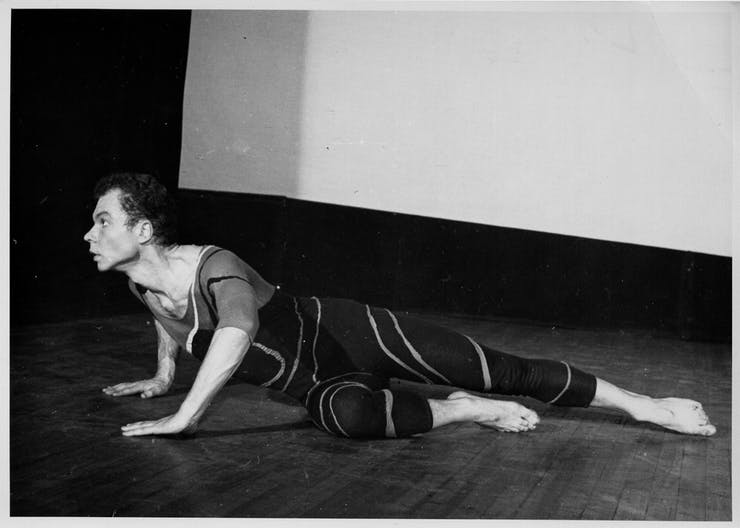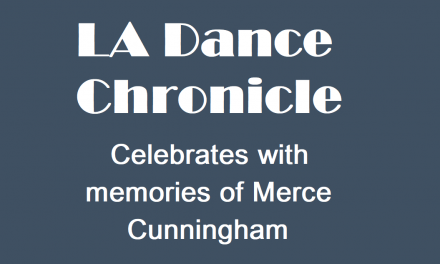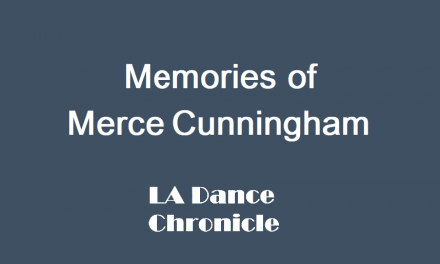It does not require a Centennial Celebration for me to remember, reflect on or to thank Merce Cunningham, as he has been a part of my life since I first met Viola Farber at Adelphi University in 1966. Viola was on the selection committee when I auditioned for the department, I took class with her for the entire year, I performed in her work “Here They Come Again” on the faculty concert, and it was she who suggested that I take Cunningham’s Manhattan summer workshop in June of 1967.
Before I attended Adelphi University, the only modern dance company that I had seen was the Norman Walker Dance Company when it performed in my hometown of Richmond, Virginia. At the end of the summer workshop at the Cunningham Studio, I went with Viola Farber and Dan Wagoner to see the Cunningham Company perform at the American Dance Festival in New London, Conn. I was totally blown away by the work and the skills of the performers; Cunningham’s “Winterbranch” being the dance that made me want to work with him. I had never seen anything like it. I did not understand it but knew that I was inspired in a way that I had not experienced before.
I never returned to finish my degree at Adelphi because later that summer Merce offered me a full scholarship at his studio following that performance in New London as I stood there waiting for Viola and Dan to speak with Merce. That was August of 1967. By October of that year I had become a member of the Merce Cunningham Dance Company. I joined the company after only seeing them perform once and studying at the studio for less that three months. I knew nothing about what I was signing up for. I had no idea that the dance community considered Merce Cunningham a genius nor anything about the history of modern dance. I had a lot of catching up and self-educating to do.
Merce Cunningham took a chance on a tall, skinny, talented but inexperienced young dancer and gave him his first professional job. I was talented and loved to dance, but my technique was not at the level of the other company members. Merce insisted that I take both the intermediate and advanced classes when I could fit them into my schedule. That was difficult as I still had to work a part time job in order to pay the rent, plus rehearse with the company for three hours a week. During those years, the company was only paid for performances and touring. We rehearsed in New York for free and did so willingly.
Because of Merce Cunningham, I toured with the company in cities across the United States, Paris, Mexico City, Rio de Janeiro, Buenos Aires, Caracas, Stockholm, Amsterdam and other cities in Sweden. I was in the company’s dance film for television “Assemblage” made on location in Ghirardelli Square in San Francisco, where we danced throughout the square and over its rooftops. I saw parts of the world and met people from different cultures that I never would have been able to meet coming from the background that I did. I received an education into the arts and the world that only a few can claim.
I met and worked with world-famous artists that included Marcel Deschamps, Jasper Johns, Robert Rauschenberg, Max Ernst, Frank Stella and Bruce Neuman. I went out and purchased an art book to learn more about who we were working with or having dinner with. I met Marcel Deschamps before I knew who he was or that he was a famous painter. Same with Jasper Johns and Robert Rauschenberg.
I performed onstage along with Merce Cunningham, Carolyn Brown, Barbara Lloyd (Dilly), Sandra Neels, Gus Solomons, Jr., Albert Reid, Meg Harper, Susanna Hayman-Chaffey, Chase Robinson, Mel Wong and Douglas Dunn. Meeting and working with all these incredible artists was because of meeting, studying, and working with Merce Cunningham.
In Stockholm, I sat on the floor next to the piano while David Tudor give an amazing performance of the music for the duet with Merce Cunningham and Carolyn Brown titled Night Wandering (Nattvandrare) choreographed in 1958. While in the company I worked with musician/composers John Cage, Gordon Mumma, Tudor, and David Behrman, and performed to the music of John Cage and others.
I performed in Cunningham’s “Nocturns” (1956); “Field Dances” (1963); “Winterbranch” (1964); “How To Pass, Kick, Fall and Run” (1965); “Variations V” (1965); “Place” (1966); “Scramble” (1967) and “Rainforest” (1968). I had the honor of being the original cast of “Walkaround Time” (1968); “Canfield” (1969); “Second Hand” (1970); and “Tread” (1970), and when the company celebrated its 50th Anniversary in 2002, I was asked to contribute to the reconstruction of “How To Pass, Kick, Fall and Run”. The company toured on buses, trains and by airplane, and throughout, we shared many meals together.
Merce Cunningham opened doors that this naïve young man from the South would never have known existed had he remained at home and not bravely ventured toward New York in hopes of become a dancer. Because of him and my many years with the Viola Farber Dance Company, I received teaching job opportunities that are often only offered to people with my experience. That experience earned me a tenured Full Professorship in the Department of Dance at California State University, Long Beach without a formal college degree.
Merce Cunningham and Viola Farber’s choreography is in my dancer muscles still. The Cunningham technique is extremely difficult. I owe most of my training to Viola Farber’s stellar teaching, but it was Merce Cunningham who gave me my first professional job and who allowed me to learn how to dance while performing onstage. Did I know at the time “who” Merce Cunningham was? No, but simply being in the same space with him gave one the sense that he was a force of nature. Viola had that same quality, so it was clear why the two of them made a miraculous dancing duo.
I no longer dance, but if I close my eyes and let myself dream, I am back onstage watching Merce Cunningham fly by me as he leapt across the stage as very few could. One critic said that he jumped like a gazelle. It was an apt description. When he was onstage, no one else was watched; except perhaps Viola Farber whose presence rivaled Cunningham’s. No one else danced like he did. He was truly unique, and he did not have to work at it.
Merce Cunningham could be difficult, but then who is not? He was a genius and he changed the way dance and choreography were looked at for an entire generation. He proved that movement could stand on its own without a storyline or obvious emotional overtones. He caused thousands, if not millions, of people to see that dance, music and paintings or sculptures can exist in the same space for no other reason than that; sharing the same space and time.
Thank you Merce Cunningham for believing in me and for giving me the opportunity to experience a life and career that very few ever have the chance to realize. When I left Richmond in 1966, dancing as a profession was only a dream. Merce Cunningham, Viola Farber and others during those years, made that dream a vivid reality. This year has brought back memories; both good and not so good, but memories that I will forever cherish.





